
Looking after your XL bully
Last year, the government added XL bullies to the dog breed types banned in England and Wales. Restrictions have now come into force with more measures for owners this year.
XL bully ban explained
The government has added XL bully types to the list of banned dangerous. It's now illegal to breed, sell, advertise, exchange, gift, rehome, abandon or allow XL bully type dogs to stray in England and Wales. You should also have a certificate of exemption from the government and comply with additional restrictions including keeping them on a lead and muzzled in public, having them neutered and having third party liability insurance.
In Scotland, as of 23 February 2024, XL bully type dogs are now also banned. It has become an offence to breed from, sell, abandon or give away dogs of this type. You must also have your XL bully type on a lead and wearing a muzzle when in public.
Scottish XL bully type owners will have until 31 July 2024 to apply for a certificate of exemption for their dog. The Scottish government have confirmed that the cost of exemption will be £92.40 per dog.
Northern Ireland has announced that similar restrictions around the keeping of XL bully types will be introduced. No timeframe has been set yet for the introduction of this new scheme.
What is an XL bully?
An American bully XL, known as an XL bully, is the largest of the American bully types. They are not a registered breed with the Kennel Club in the UK and are a type of dog that has been bred from several different dog breeds.
How is an XL bully ‘type’ defined?
XL bullies are crossbreeds and Kennel Club breed standards do not exist. The government has therefore created its own specifications for the breed, which includes the size of their head and muzzle, their build, and the height and length of their body. Breed name, genetics and parentage are not considered.
The government has confirmed that the minimum height specified is a necessary requirement to meet the XL bully type specifications. The height should be measured from the ground to your dog’s withers (the top of the shoulders). For adult males this is from 20 inches, and females from 19 inches. Dogs that do not meet this height requirement will not be typed as an XL bully. If they do, they should be assessed against the rest of the specifications.
I own an XL bully
We know that many XL bully type dogs are much-loved family pets. To keep them from being seized, you'll need to make sure:
- you have your certificate of exemption
- your dog is microchipped and neutered (by the deadlines provided)
- they are kept on a lead and muzzled in a public place, including in cars
- they are kept in a secure place so they cannot escape
- you have third party public liability insurance cover for your dog
You also need to be at least 16 years old to own or walk an XL bully type.
You'll also need to tell Defra if you move address (except for the permitted 30 days when your dog can be kept at another address within a 12 month period), is exported or if your dog passes away.
I’m worried my puppy might look like an XL bully type?
It’s now illegal to sell or rehome an XL bully type puppy. However, the specifications for an XL bully type are broad. If you're concerned your dog might fall into these specifications, the government recommends taking a precautionary approach.
You should contact Defra directly for more advice on whether your dog is of type and further information on how to have your dog exempted.
Note
If your dog is another established breed such as those recognised by the UK Kennel Club with some similar characteristics to an XL bully, you do not need to worry about the ban, however crossbreeds might be affected.
Applying for exemption
Now that the government’s XL bully exemption scheme has closed, you must go through the existing process for exempting a dog listed as a banned breed. This will involve going to court to prove your dog is not a danger to the public.
If you have applied for a certificate but not received it
If you’re asked to show your certificate of exemption but you have not yet received it, you can show evidence that you’ve applied.
Defra may be able to help you complete your application if you:
- paid the fee but did not send the application before midday on 31 January 2024
- did not pay the fee but sent the application before midday on 31 January 2024
They may also be able to help you if you made a mistake in your application (such as providing an incorrect payment reference number). For help with your application, contact [email protected] with your name, postcode and the name of your dog.
Can my dog leave the exemption scheme?
The government has confirmed that there will be a way of leaving the exemption scheme if you applied for exemption as a precautionary approach.
We are waiting for more details from Defra on this process, but it’s unlikely your fee will be refunded.
Restrictions for XL bully types
Mandatory microchipping
Microchipping is required for all dogs by law. Check that your dog is microchipped and that your name, address and contact details are up to date.
Proof of neutering for XL bully types
Ask your vet for proof of neutering using this form. Your vet may charge for this service.
You’ll need to submit the form to Defra by a certain date depending on the age of your dog.
Neutering and form deadlines
If your dog is not neutered, speak to your vet about scheduling this procedure as soon as possible.
- If your dog was under seven months old on 31 January 2024, they must be neutered and you must return a completed form to Defra by 20 June 2025
- If your dog was aged seven to 12 months on 31 January 2024, they must be neutered and you must return a completed form to Defra by 31 December 2024
- If your dog was older than one on 31 January 2024, they must be neutered and you must return a completed form to Defra by 30 June 2024
Note
We’ve teamed up with RSPCA and Battersea to offer support to neuter your XL bully type dog if you’re struggling financially. Your veterinary practice can apply for a financial contribution on your behalf which will help towards the cost of neutering.
Third party public liability insurance cover
You need to take out annual third party liability insurance for your dog which protects you if your dog injures another person. Dogs Trust provide this through their membership scheme.
Muzzle training
Your dog needs to wear a muzzle when out in public, including in cars, and be walked on a lead at all times.
We know that many dogs may still be struggling to feel comfortable wearing a muzzle out and about. Make sure you continue to use positive reward-based training at home and in public, so that your dog builds their confidence wearing a muzzle and it continues to be a fun experience.
More advice on muzzle training
Keeping your dog on lead
Your dog must be kept on a lead in public places and must be held by someone at least 16 years old. The law does not say how long your lead needs to be, but your dog must be in control. Long leads may be interpreted as breaking the terms of your exemption.
Tip
Remember, it’s not just out and about that your dog can enjoy. We’ve got lots of enrichment ideas for your dog at home and in a secure garden.
Hiring private fields
The Crown Prosecution Service has issued guidance that XL bully types can be exercised in private grounds, paddocks or other places not accessed by the public in general. If hiring a field, always check with the venue beforehand.
Breeding XL bully types
It is now illegal to breed from, sell, abandon and give away an XL bully type. If puppies were born after the 31 December, you’ll have to keep the puppies or have a vet put them to sleep.
Speaking to your housing provider
Many councils and housing associations do not allow dogs that fall under the Dangerous Dogs Act, even if they have proved to the court that they are not a danger to the public. Some housing associations have confirmed they will allow exempted XL bullies.
Check with your landlord, housing association or council to find out their policies following the ban.
Exempting your XL bully type dog in Scotland
Scotland has announced the requirements for getting a certificate of exemption for your XL bully type.
- Your dog must be microchipped by the time they are eight weeks old
- They must be neutered by the time they are 18 months old
- You must have third party public liability insurance for your dog
- You must pay the application fee of £92.40
You can apply for exemption online by 31 July 2024, or by post by 15 July 2024.
What about unowned dogs?
The Dangerous Dogs Act makes it illegal to own a banned type unless they are exempt, but it also makes it illegal to breed from, rehome or sell these dogs. We continue to be concerned that the Dangerous Dogs Act penalises innocent dogs.
Charities like ours cannot now rehome XL bullies, even when they're well behaved and well socialised.
There's still time to help us raise awareness of the challenges of this legislation by emailing your MP in a few easy steps.
Sign up for our XL bully updates
Need some help or advice?
You are not on your own. Blue Cross is here to help you during this time of uncertainty.
Please get in touch either by phone on 0300 790 9903, or email [email protected].
Page details
Reviewed
• 3 April 2024
Next review
• 1 May 2024






